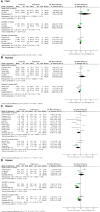The alterations of oral, airway and intestine microbiota in chronic obstructive pulmonary disease: a systematic review and meta-analysis
- PMID: 38779669
- PMCID: PMC11109405
- DOI: 10.3389/fimmu.2024.1407439
The alterations of oral, airway and intestine microbiota in chronic obstructive pulmonary disease: a systematic review and meta-analysis
Abstract
Background: Increasing evidence indicates the microbial ecology of chronic obstructive pulmonary disease (COPD) is intricately associated with the disease's status and severity, and distinct microbial ecological variations exist between COPD and healthy control (HC). This systematic review and meta-analysis aimed to summarize microbial diversity indices and taxa relative abundance of oral, airway, and intestine microbiota of different stages of COPD and HC to make comparisons.
Methods: A comprehensive systematic literature search was conducted in PubMed, Embase, the Web of Science, and the Cochrane Library databases to identify relevant English articles on the oral, airway, and intestine microbiota in COPD published between 2003 and 8 May 2023. Information on microbial diversity indices and taxa relative abundance of oral, airway, and intestine microbiota was collected for comparison between different stages of COPD and HC.
Results: A total of 20 studies were included in this review, involving a total of 337 HC participants, 511 COPD patients, and 154 AECOPD patients. We observed that no significant differences in alpha diversity between the participant groups, but beta diversity was significantly different in half of the included studies. Compared to HC, Prevotella, Streptococcus, Actinomyces, and Veillonella of oral microbiota in SCOPD were reduced at the genus level. Most studies supported that Haemophilus, Lactobacillus, and Pseudomonas were increased, but Veillonella, Prevotella, Actinomyces, Porphyromonas, and Atopobium were decreased at the genus level in the airway microbiota of SCOPD. However, the abundance of Haemophilus, Lactobacillus and Pseudomonas genera exhibited an increase, whereas Actinomyces and Porphyromonas showed a decrease in the airway microbiota of AECOPD compared to HC. And Lachnospira of intestine microbiota in SCOPD was reduced at the genus level.
Conclusion: The majority of published research findings supported that COPD exhibited decreased alpha diversity compared to HC. However, our meta-analysis does not confirm it. In order to further investigate the characteristics and mechanisms of microbiome in the oral-airway- intestine axis of COPD patients, larger-scale and more rigorous studies are needed.
Systematic review registration: PROSPERO (https://www.crd.york.ac.uk/prospero/), identifier CRD42023418726.
Keywords: alpha-diversity; beta-diversity; chronic obstructive respiratory disease; human airway microbiome; human intestine microbiome; human oral microbiome; meta-analysis; relative abundance.
Copyright © 2024 Kou, Liu, Qiao, Wang, Li, Li, Yu and Han.
Conflict of interest statement
The authors declare that the research was conducted in the absence of any commercial or financial relationships that could be construed as a potential conflict of interest.
Figures





Similar articles
-
Microbial dysbiosis in obstructive sleep apnea: a systematic review and meta-analysis.Front Microbiol. 2025 May 15;16:1572637. doi: 10.3389/fmicb.2025.1572637. eCollection 2025. Front Microbiol. 2025. PMID: 40444003 Free PMC article.
-
Analysis of the bronchoalveolar lavage fluid microbial flora in COPD patients at different lung function during acute exacerbation.Sci Rep. 2025 Apr 16;15(1):13179. doi: 10.1038/s41598-025-96746-5. Sci Rep. 2025. PMID: 40240456 Free PMC article.
-
The Specific Alteration of Gut Microbiota in Diabetic Kidney Diseases-A Systematic Review and Meta-Analysis.Front Immunol. 2022 Jun 17;13:908219. doi: 10.3389/fimmu.2022.908219. eCollection 2022. Front Immunol. 2022. PMID: 35784273 Free PMC article.
-
Gut microbiota dysbiosis in ankylosing spondylitis: a systematic review and meta-analysis.Front Cell Infect Microbiol. 2024 Oct 1;14:1376525. doi: 10.3389/fcimb.2024.1376525. eCollection 2024. Front Cell Infect Microbiol. 2024. PMID: 39421642 Free PMC article.
-
Characteristics of the sputum microbiome in COPD exacerbations and correlations between clinical indices.J Transl Med. 2022 Feb 5;20(1):76. doi: 10.1186/s12967-022-03278-x. J Transl Med. 2022. PMID: 35123490 Free PMC article.
Cited by
-
Multiomics approach reveals the comprehensive interactions between nutrition and children's gut microbiota, and microbial and host metabolomes.Nutr J. 2025 Mar 29;24(1):50. doi: 10.1186/s12937-025-01116-6. Nutr J. 2025. PMID: 40158160 Free PMC article.
-
Microbial dysbiosis in obstructive sleep apnea: a systematic review and meta-analysis.Front Microbiol. 2025 May 15;16:1572637. doi: 10.3389/fmicb.2025.1572637. eCollection 2025. Front Microbiol. 2025. PMID: 40444003 Free PMC article.
-
Association between oral microbiome diversity and chronic obstructive pulmonary disease in the US population.J Transl Med. 2025 May 17;23(1):557. doi: 10.1186/s12967-025-06553-9. J Transl Med. 2025. PMID: 40382665 Free PMC article.
-
Genetic evidence from Mendelian randomization strengthens the causality between oral microbiome and chronic obstructive pulmonary disease.Medicine (Baltimore). 2025 Jul 25;104(30):e43347. doi: 10.1097/MD.0000000000043347. Medicine (Baltimore). 2025. PMID: 40725894 Free PMC article.
-
Prognostic risk prediction model for patients with acute exacerbation of chronic obstructive pulmonary disease (AECOPD): a systematic review and meta-analysis.Respir Res. 2024 Nov 14;25(1):410. doi: 10.1186/s12931-024-03033-4. Respir Res. 2024. PMID: 39543648 Free PMC article.
References
-
- Adeloye D, Song P, Zhu Y, Campbell H, Sheikh A, Rudan I. Global, regional, and national prevalence of, and risk factors for, chronic obstructive pulmonary disease (COPD) in 2019: a systematic review and modelling analysis. Lancet Respir Med. (2022) 10:447–58. doi: 10.1016/S2213-2600(21)00511-7 - DOI - PMC - PubMed
Publication types
MeSH terms
LinkOut - more resources
Full Text Sources
Medical

